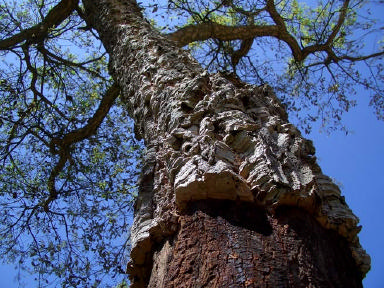Sustainability at the Heart of Cork Support
The first reference to cork dates to 3000 B.C., in China, where it was used as part of fishing equipment.
Cork was first used as a stopper for wines in 1670 by the French abbott Dom Perignon for the sparkling
wine of his Hautvilliers’ monastery (prior to this, wine was closed with wooden bungs wrapped in
hemp).
Cork is made from the bark of the cork oak tree and no trees are cut down for cork production. The
average lifespan of a cork oak varies between 170 and 200 years. This means the tree can regenerate
cork suitable for wine closure about 17 times in its life. Each time a cork tree is harvested, the cork
bark regenerates itself. The world’s supply of cork is not dwindling as there is about 4% growth from
natural regeneration and plantings. The photo below is a cork tree in South West France (Tony Boon).

Fifteen billion natural cork stoppers are produced each year. Cork is a recyclable, renewable and
reusable product. Larry Walker, writing in Wines & Vines (August 2007), points out that “cork oak trees
store carbon dioxide in order to regenerate, and therefore a harvested cork oak tree absorbs 3 to 5
times more than one which is not harvested, thus benefiting the atmosphere.” He goes on in his argument
to support the sustainability value of cork noting that a report in Off License News stated that “1
million corks create 3.26 tons of carbon dioxide a year, while 1 million screw caps are responsible for
14.27 tons.” Cork oak forests in Portugal, Spain, Algeria, Morocco, Italy, Tunisia and France provide
income for a sizeable number of people and support a number of endangered species.
The cork industry has spent millions of dollars over the past 10 years to ensure cork quality has improved.
Carbon dioxide washed and steam washed corks have either eliminated TCA or reduced
TCA below threshold levels. A French cork supplier claims to have eliminated TCA taint entirely and
another one in Portugal has reduced TCA taint to under 1%.
Paul White, writing for the Slow Food movement, summarizes the value of cork. “For more than two
centuries, winemaking, wine maturation and, indeed, wine styles have been closely allied to the mechanical
and chemical properties of cork. Indeed, without cork humanity would never have defined
the concept of terroir. Where a few years ago cork looked like it was staggering along on its last legs,
it now seems to have picked itself up by the bootstraps, dusted off its nastiest habits, and seems to be
facing a relatively bright future. And from a Slow Food perspective, that’s a good thing.”